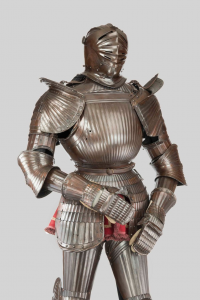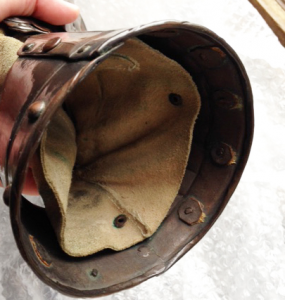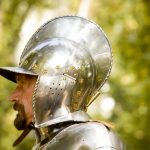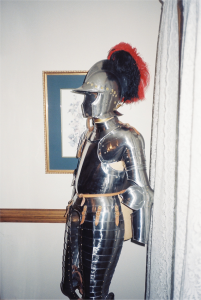Having viewed a myriad of documentaries exploring lost treasures from throughout history including the Ark of the Covenant, the Holy Chalice, and the legendary Lost City of Gold I was hesitant about piling yet another mystery onto the heap. But since I am certain that any day now most of those afore mentioned treasures will be recovered from the Oak Island money pit I thought it safe to finally reveal the Mystery of the Copper Maximilian Armour.
 Several years ago I chanced across an impressive suit of Maximilian armour for sale of unknown origin. The seller represented the suit as a well-executed Victorian replica largely because it was hammered out of copper instead of iron or steel. The workmanship on the armour is superb with closely spaced fluting on the cuirass, pauldrons, and other elements of the armor. Unlike more cheaply made replica armours the flutes are edged along both sides with a chiseled groove accentuating the beauty of the fluting. The cuirass is short-waisted and of globose form just like the originals. The helmet has a neck-guard composed of three articulated plates but is not nearly as appealing to the eye as the rest of the armour. Supposedly the armour was originally “tinned” to give it the appearance of steel, however I can find no evidence of tin plating anywhere on the surface even in hidden recesses where it wouldn’t have easily worn away. The copper is somewhat tarnished from age and I decided not to polish it since it might damage the surface or diminish the value of the suit. I had actually considered re-tinning or silver plating the surface to give it more of the appearance of an original armour.
Several years ago I chanced across an impressive suit of Maximilian armour for sale of unknown origin. The seller represented the suit as a well-executed Victorian replica largely because it was hammered out of copper instead of iron or steel. The workmanship on the armour is superb with closely spaced fluting on the cuirass, pauldrons, and other elements of the armor. Unlike more cheaply made replica armours the flutes are edged along both sides with a chiseled groove accentuating the beauty of the fluting. The cuirass is short-waisted and of globose form just like the originals. The helmet has a neck-guard composed of three articulated plates but is not nearly as appealing to the eye as the rest of the armour. Supposedly the armour was originally “tinned” to give it the appearance of steel, however I can find no evidence of tin plating anywhere on the surface even in hidden recesses where it wouldn’t have easily worn away. The copper is somewhat tarnished from age and I decided not to polish it since it might damage the surface or diminish the value of the suit. I had actually considered re-tinning or silver plating the surface to give it more of the appearance of an original armour.
After displaying the armour for a single event I carefully stored it away awaiting the time when space will hopefully become available to exhibit it on a more permanent basis. I hope to create a continuum of arms, armour, and museum quality model ships to visually demonstrate the many advances in these areas during the Great age of Discovery (1492 through the early 17th century and the establishment of Henricus). I have already obtained several original weapons (a matchlock musket and a wheellock carbine) and components of period armor for the display along with several ship models. Hopefully this dream will become a reality and augment the Sea Lion ship exhibit once it arrives at Henricus Historical Park.
It has baffled me somewhat since first obtaining the suit as to why anyone would have worked with copper instead of steel unless plating the surface with silver, gold, or some other medium was their intention. Recently, with the excitement of the holidays ebbing a bit, I decided to inspect the armour a bit more closely.
First off, I noticed evidence of earlier attachments for the gloves inside the mitten gauntlets as well as rivets of a more modern form present from place to place attaching replacement leather straps to the suit. There were signs of light pitting here and there as well, a somewhat perplexing observation since the suit was supposedly made of copper. Then, whilst manipulating the lames of one of the gauntlets, I noticed a shiny glow beneath the dull surface where one of the scalloped edges had worn away the copper.
Upon closer examination with a magnifying glass I realized the metal beneath was steel. I leapt up from my chair and ran to the refrigerator, which in my house is covered from top to bottom with magnets of all sorts from tourist haunts across the planet. Grabbing one of the magnets I returned to my work space and quickly discovered that the entire gauntlet was made of steel. Fighting my way through Christmas debris in the storage room to the boxed armor I tested the other elements of the suit and discovered they were steel underneath as well. No matter where I placed it the magnet clinked solidly against the metal and stuck fast. The original rivets appear to be steel as well, though they are too close to the rest of the surface to be absolutely certain. Why, the realization struck me, had I never thought of the possibility before? I had figured all along that the description provided by the seller, a well-respected dealer, was accurate, but in retrospect realized he was relying on an appraisal from another party just as well.
I was ecstatic, since I had always considered the armour to be merely decorative, no matter its age or beauty, since copper would never have turned a lance or crossbow bolt as well as steel. No self-respecting man-at arms would have chanced wearing such a suit other than on parade. A parade armour is not nearly as desirable for the purposes of our future display as an actual field armour.
Though it was New Year’s Eve I called a friend and renowned armourer, James Arlen Gillaspie, to discuss my discovery. James has handled some of the finest armor in the world and is an expert in the field. He answered on the forth ring and was almost as baffled as I was at why anyone would copperplate such a fine suit of armor. According to James it could have been done with the intention of gold or silver plating the suit. Or perhaps the copper plating was an effort to cover-up the damaged or pitted surface of an otherwise well-proportioned period armor. The rivets being steel as they appear, instead of a non-ferrous metal as common on Victorian replicas, would be added evidence that some components of the armour might have been made in an earlier age.
With several tall stacks of books on armour and weapons, as well as a plethora of catalogs from armor sales unable to give me an answer, I turned to the internet, but once again without any real success. Soon I’ll be packing up a few of the smaller items from the armour and shipping them off to James Gillaspie to hopefully get an answer from an expert. Until then I sit here in wonder, much like Geraldo Rivera poised before Al Capone’s secret vault, contemplating what truth lies behind the mystery of the copper Maximilian Armour.




